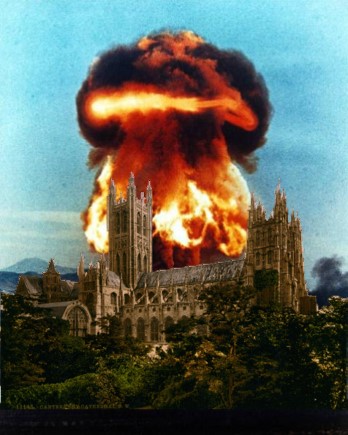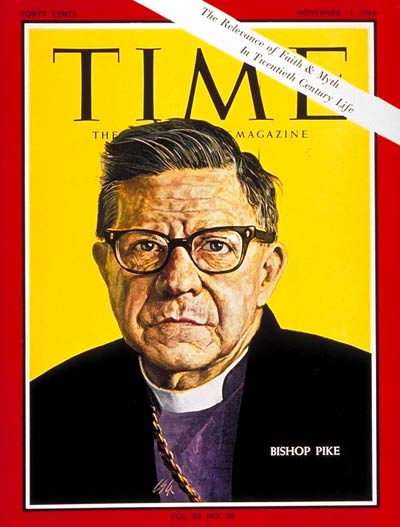How about some ecclesiastical math?
 OK, let's take this logically. In the summer of 2006, Father Martyn Minns of Truro Episcopal Church outside Washington, D.C., became Bishop Martyn Minns of the Convocation for Anglicans in North America, a missionary effort of the gigantic Anglican Church of Nigeria. That would be three years ago.
OK, let's take this logically. In the summer of 2006, Father Martyn Minns of Truro Episcopal Church outside Washington, D.C., became Bishop Martyn Minns of the Convocation for Anglicans in North America, a missionary effort of the gigantic Anglican Church of Nigeria. That would be three years ago.
A year later, the Diocese of Virginia expelled a bunch of clergy from its active roster of priests, "inhibiting" them from priestly duties. Minns was not in that list, even though he was the bishop overseeing the work of many of these rebel Episcopalians turned alternative Anglicans. It is also interesting to note that Virginia Bishop Peter James Lee said he had licensed Martyn to serve as priest-in-charge at Truro through Jan. 1, 2007.
I admit that this is pretty complicated stuff.
Nevertheless, I don't think there is any way to do the math on Minns and end up with this reference in a Los Angeles Times update story about the proceedings at the 2009 General Convention of the Episcopal Church, meeting in Anaheim. This chunk of the story begins with a quote from the overjoyed Bishop V. Gene Robinson of New Hampshire, celebrating the House of Bishop's decision to allow dioceses to proceed with the ordination of sexually-active gays and lesbians as bishops.
"I'm simply delighted at the possibility that another diocese will recognize the gifts of a gay or lesbian clergy person," he said. "I long for the day when someone who shares my experience as an openly gay bishop joins me in the House of Bishops. It has been lonely."
But a bishop who left the church last year predicted that the decisions made in Anaheim would increase strains with disaffected conservatives.
"Clearly the activists have done a good job promoting their agenda," said the Rt. Rev. Martyn Minns, a founding bishop of the newly formed Anglican Church in North America, which hopes to gain recognition from the Anglican Communion as a rival province to the Episcopal Church.
"The generosity shown by the rest of the communion has been astonishing and has been thrown back in their face," Minns said. "There will have to be a renegotiation of how the Episcopal Church fits into the family."
Now, if Minns was consecrated as an Anglican bishop outside of the Episcopal Church in 2006 and then his license to lead his church ran out on Jan. 1, 2007, I don't know how it is possible to say that Minns "left the church last year." It's possible that Bishop Lee & Co. sent him some final letter last summer and that I cannot find that reference using Google. Hey, it could happen (and please correct me if I missed something).
Now, I know that this is picky. However, the timeline issue is not going to go away. Sure enough, this same story falls right into the same time-warp trap that has ensnared so many other journalistic offerings, as of late. (I wrote my Scripps Howard News Service column for this week about this topic and here's a link to that.)
Once again, we hear that:
Tensions have been mounting since 2003, when a partnered gay priest, V. Gene Robinson, was consecrated as bishop of New Hampshire. Several conservative Anglican leaders, especially in Africa, cut ties to the U.S. church after his election.
The spiritual leader of the Anglican Communion, Archbishop of Canterbury Rowan Williams, had expressed apprehension during a brief visit to the conference last week about decisions "that could push us further apart."
 So forget Bishop James Pike and the heresy debates of 1967.
So forget Bishop James Pike and the heresy debates of 1967.
Forget Bishop Paul Moore's bold 1979 ordination of a lesbian priest in the hot media spotlight that is always aimed at the Diocese of New York. In fact, forget all kinds of things about that particular bishop.
Forget Bishop John Spong's 1989 ordination of a gay priest who was living in a same-sex relationship. Forget Utah Bishop Otis Charles outing himself. Forget Spong's Koinonia Statement in 1994 and his 12 theses offering a liberal faith without the God of the Bible. Forget the heresy trial of Bishop Walter Righter in 1996.
Forget the Kuala Lumpur statement from conservative archbishops in the Global South in 1997 or the stunning, historic Lambeth Conference statement on sexuality in 1998.
Forget the consecration of two missionary bishops to North America in 2000 by archbishops from Rwanda and Southeast Asia, a tipping point that hinted at what was to come.
Forget all kinds of things.
Remember, it's important to keep repeating this mantra: The tensions began in 2003 and it's all about a gay Episcopal bishop in New Hampshire.
The story is so much easier to cover if you simply chop off all of that other information and all those picky details about the Bible, the Creeds, sacraments, liturgies and all that other messy stuff. That strategy seems to be the norm in the mainstream news coverage right now.
I know that writing about history and doctrine is hard sledding. But how about some basic math? Is that too much to ask?